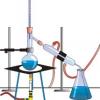Hi colleagues
I have a quick question. I am looking at a process safeguarding memorandum, specifically the relief device on a natural gas heater (the heated gas is used as defrost gas). The heating medium is an electrical heating element.
One of the contributing cases is stated as "relief due to blocking in of the exchanger while the temperature elements are still heating, causes the defrost gas temperature to rise, resulting in thermal relief." (No credit is taken for the functioning of high temperature trips installed).
My question: How would you go about calculating a relief load for this? I know formulae (from ISO23251) for calculating relief load due to external heat input (from fire) for both gas and liquid service.
However I cant seem to find anything for or analogous to internal heating in a blocked heat exchanger/vessel in gas service, and I am struggling to figure out how I would estimate the relief load from this case i.e. heating element is on, exchanger is gas filled and blocked in at (I assume) at the operating pressure, which is ~50 bara. The relief valve set pressure is set at 60 bar (with 10% overpressure allowed)...
Thanks for any help!
Regards
Ogeds

 FB
FB












